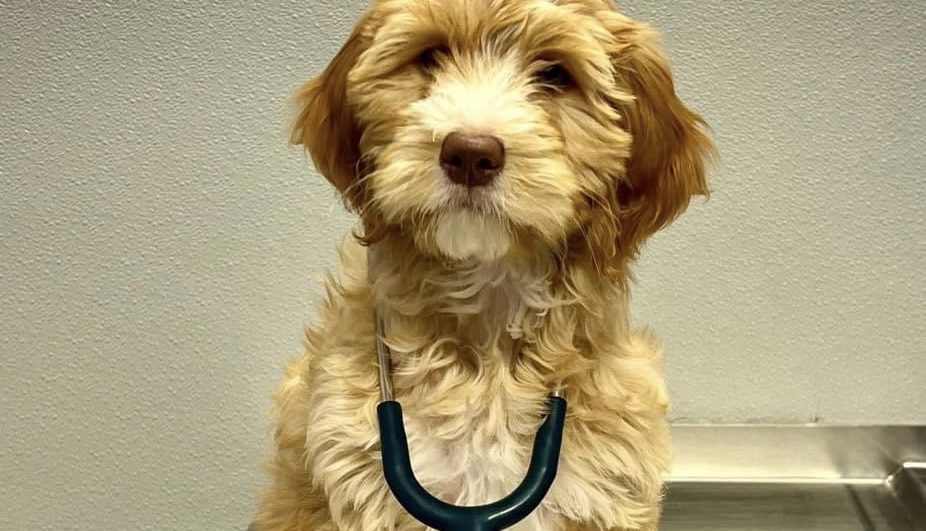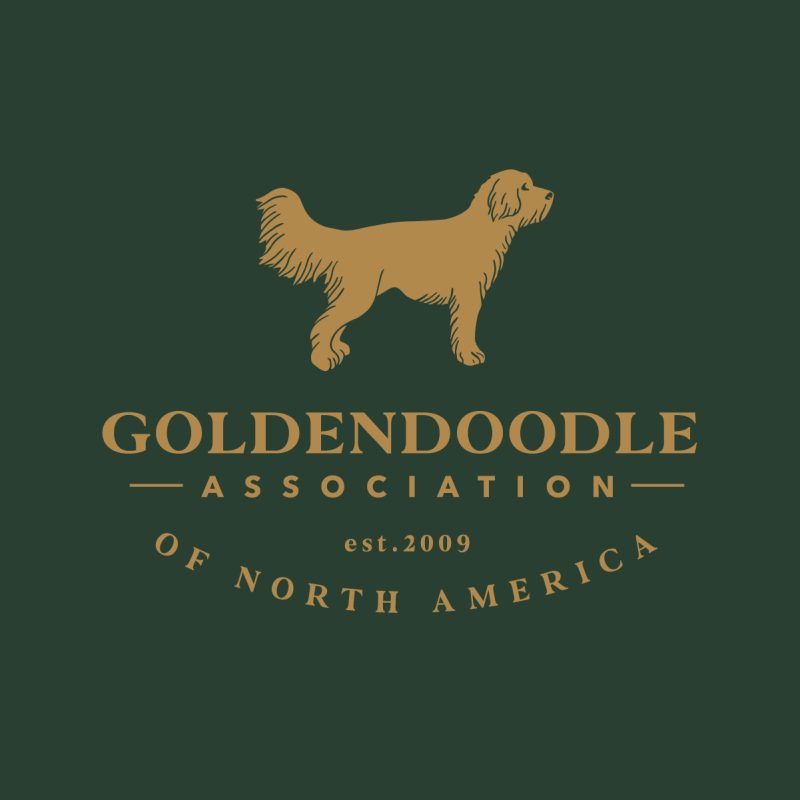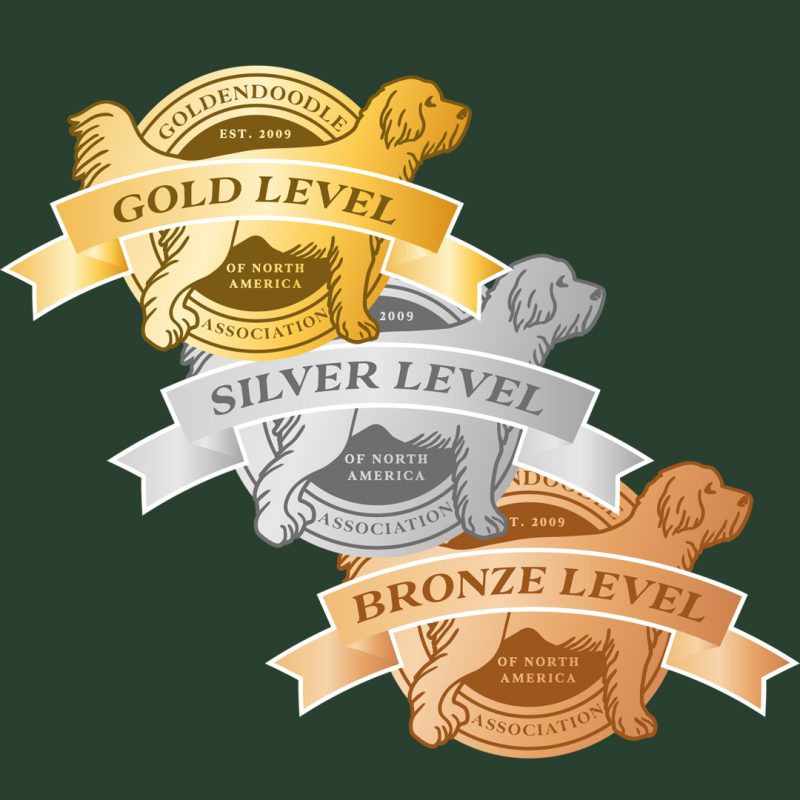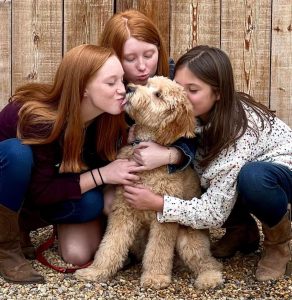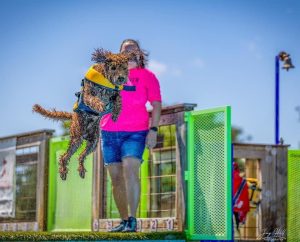All GANA™ breeders are required to perform specific health tests on their breeding dogs. Each breeder that is in good standing with GANA will have a custom logo which includes their kennel name, the year they became a member, their health testing level, and a valid expiration date. Any other logo is not proof of membership with GANA.
All health testing requirements outlined below apply to new GANA member breeders and to dogs born on or after July 31, 2024.
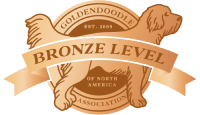
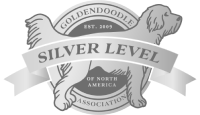

| Disease/Variants | Applicable Breed | Bronze | Silver | Gold |
|---|---|---|---|---|
| Health Tests | ||||
| Hips* | All | |||
| Heart** | GD, GR | |||
| Patellas | P, GD (all sizes) | |||
| Elbows | All | |||
| Eyes (CAER every 2 years) | All | |||
| Genetic Disease Tests | ||||
| Progressive Rod Cone Degeneration (PRCD-Pra) | All | |||
| Von Willebrand Disease (vWd Type 1) | GD, P | |||
| Neonatal Encephalopathy with Seizures (NEWS) | GD, P | |||
| Golden Retriever Progressive Retinal Atrophy (GR-PRA2) | GD, GR | |||
| Golden Retriever Progressive Retinal Atrophy (GR-PRA1) | GD,GR | |||
| Ichthyosis (ICH1) | GD, GR | |||
| Degenerative Myelopathy (DM) | All | |||
| Optional Genetic Disease Tests | ||||
| Chondrodysplasia & Chondrodystrophy (CDPA/CDDY) | GD, P (toy, mini, medium only) | |||
| Intervertebral Disc Disease (IVDD Type 1) | GD, P | |||
|
GR = Golden Retriever | GD Goldendoodle | P = Poodle |
||||
Health Tests
Note: GANA requires that a veterinarian must verify the microchip or tattoo for all health testing through the Orthopedic Foundation for Animals (OFA) and must check the box: “I did verify microchip/tattoo on this dog”. GANA requires all health testing for hips, elbows, heart, patellas, and eyes to be submitted to the OFA for issuance of a passing certificate. The GANA registration number of the canine tested must be included on the certificate.
Hips*
To qualify for registration, hips must be evaluated by OFA, PennHip Distraction Index, British Veterinary Association Hip Dysplasia Scheme, or eVet Diagnostics, LLC.
- OFA: Prior to breeding, OFA Preliminary Evaluation, OFA Final Evaluation, or eVet Diagnostics report for hips must score Fair, Good, or Excellent. If OFA preliminary evaluations (between 4 months and 24 months of age) result in a FAIR score, hips must be retested after the dog is 2 years old.
Chemical restraint, though not required, is recommended. With chemical restraint optimum patient positioning is easier with minimal repeat radiographs (less radiation exposure) and a truer representation of the hip status is obtained.
- PennHip Distraction Index (DI): The PennHip DI must be performed at 4 months of age or later and must be equal to or tighter than the breed average with no evidence of osteoarthritis (OA). Pennhip reports a dog’s hip laxity or DI relative to the average hip laxity for the breed permitting breeders to identify dogs whose DI will apply meaningful selection pressure to decrease the occurrence of hip dysplasia in the breed.
- British Veterinary Association Hip Dysplasia Scheme (BVA): Passing BVA test results for hips will be accepted if the testing was done in Europe. Passing BVA results consist of a BVA total score of 1-10 for both hips taken at or after one year of age as long as no single hip score is greater than 6. Dogs with a BVA of 11-18 total score, or with a score of 0-10 but with a single hip score greater than 6 taken at one year or later are accepted as passing, but with the requirement that to become permanent, testing must be repeated.
- eVet Diagnostics: Preliminary hip evaluations according to OFA standards. This group of board-certified radiologist veterinarians focus on diagnostics (X-rays, ultrasounds, and CT Scans) for veterinary hospitals. Radiographs obtained at 2 years of age will need to be evaluated to exclude hip dysplasia and establish a final rating via OFA.
Heart**
Basic Cardiac clearance is issued for any dog found to be normal for cardiac disease at one year of age or older. A stud may qualify for breeding prior to the age of one with an OFA Cardiac Preliminary Evaluation, though this does not result in OFA certification. In this circumstance, the stud will need to have an OFA Basic Cardiac final clearance after the age of one. Heart clearances after 7 mos. of age will be accepted for males if they are to be bred prior to a year of age. Heart clearances need to be completed again between 12 and 14 mos. of age to achieve a permanent clearance; males may breed for as long as they are able to produce healthy litters.
Eyes
The Companion Animal Eye Registry (CAER) exam must be performed every 2 years (30-day grace period) for the breeding life of the dog.
Elbows
Preliminary or Permanent rating of Normal is required after 4 mos. of age from OFA or eVet Diagnostics. Passing BVA test results for elbows will be accepted if the testing was done in Europe.
Patellas
PATELLAS
A permanent OFA Patella clearance is required for all Mini and Toy Poodles, as well as Petite, Mini, Medium, and Standard Goldendoodles. Studs may be used for breeding before the age of one if they have received a preliminary OFA Patella clearance, which must be done after seven months of age. However, in order to meet full health testing requirements, a permanent clearance must be completed after 12 months of age. Once a male has received his permanent OFA Patella clearance, he may continue to breed.
Genetic Disease Tests
The following diseases are autosomal recessive meaning that 2 copies of the gene coding for the disease are required for the dog to develop the disease.
Unless otherwise indicated, at least one parent must be unaffected by the disease or clear of 1 copy (i.e., a carrier) of the gene for the following diseases to continue GANA’s mission of eliminating diseases in the breed.
For a breeding dog to be ‘clear via parentage’ both parents must not carry the gene. For a dog to qualify for breeding, DNA must be analyzed by an approved canine genetics lab. Alternatively, submitting both parent dog’s clear DNA test results from qualifying labs demonstrating they are both not carriers of the gene, qualifies for registration.
Progressive Rod Cone Degeneration (PRCD-PRA)
Progressive Rod Cone Degeneration (PRCD-PRA) is caused by degeneration of rod and cone photoreceptor cells in the retina. Most dogs show signs of vision loss and/or loss of peripheral vision at approximately 3-5 years of age. As the affected dog ages, changes in the Tapetum (behind the retina) can be observed in a veterinary eye exam. Most dogs eventually become blind.
- Applicable Breeds: Poodles, Golden Retrievers, Goldendoodles
GR-PRA1 and 2 affected dogs typically develop symptoms of night blindness or loss of peripheral vision at approximately 6-7 years of age.
- Applicable Breeds: Golden Retrievers, Goldendoodles
Von Willebrand Disease (vWd Type 1)
Von Willebrand Disease (vWd Type 1) is a canine bleeding disorder. Golden retrievers are not at risk for developing this disease, so testing is not required.
- Applicable Breeds: Poodles and Goldendoodles
- Required: One clear in the breeding pair or having a golden retriever in the breed pairing.
Neonatal Encephalopathy with Seizures (NEWS)
Neonatal Encephalopathy with Seizures (NEWS) is a developmental brain disease. NEWs symptoms include extreme weakness, often accompanied by severe seizures. Symptoms get progressively worse, and puppies usually do not survive past 7 weeks of age. NEWS is classified as a severe disease.
- Applicable Breeds: Poodles, Goldendoodles
Progressive Retinal Atrophy (PRA)
Progressive Retinal Atrophy (PRA) is a condition of the eye. PRA is a group of diseases that eventually leads to blindness. It has mild effects and generally does not pose any significant health concerns or is easily managed. PRA affecting Goldendoodles is recessively inherited. Three forms of PRA affect Goldendoodles: PRCD-PRA, GR-PRA1, and GR-PRA2.
- Impact: low degree of severity
- Inheritance: Autosomal Recessive
- Result types: Affected, Carrier, or Clear
- Severity: PRA has a moderate degree of severity, it is not a fatal disease, though it can decrease the quality of life.
Ichthyosis A (ICH)
Ichthyosis A (ICH) is a skin condition where the skin becomes thickened and scaly. Because this condition allows the skins integrity to be impaired, secondary infections or irritations may occur. The greatest impact is the appearance of the dog and the irritation it causes, although the disease itself is not life-threatening. ICH can manifest in different degrees from mild to severe. ICH is classified as a moderate degree of severity since it is not a fatal disease though it decreases quality of life.
- Applicable Breeds: Golden Retrievers, Goldendoodles
Degenerative Myelopathy (DM)
Degenerative Myelopathy (DM) is an adult-onset neurologic condition with progressive limb weakness and muscle loss, usually occurring around middle age. Other factors often play into the development of this disease. Dogs that carry two genes for DM (affected) are at risk but may not show symptoms. DM is classified as a high degree of severity when the disease manifests as it can significantly decrease life expectancy and quality of life.
- Applicable Breeds: Poodles, Golden Retrievers, and Goldendoodles
- Mode of Inheritance: Autosomal Recessive with Incomplete Penetrance
Optional Genetic Disease Tests
Chondrodysplasia, Chondrodystrophy (CDPA/CDDY), and Intervertebral Disc Disease (IVDD Type 1)
Chondrodysplasia (CDPA) is a short-legged phenotype characteristic of many dog breeds (e.g., corgis, dachshunds). Chondrodystrophy (CDDY), caused by a separate short-legged genetic mutation, causes premature degeneration of intervertebral discs and susceptibility to Hansen’s type I Intervertebral Disc Disease (IVDD).
GANA recommends breeders test for CDDY in their breeding dogs so that we can monitor the occurrence of CDDY/IVDD in Goldendoodles. Currently there does not appear to be any association with the CDDY gene and IVDD disease in Goldendoodles. For the purposes of data collection and research, breeders should track IVDD for any correlation and report findings to GANA.
Removing dogs with specific genes from breeding programs is not always the best response to a disease. Therefore, we are recommending that if breeders do decide to eliminate this gene from their breeding program, that they consider that associated genes not yet identifiable, may also be eliminated, and the best plan is to breed the gene out slowly.
Note: results from Embark will not be accepted as they only offer a linkage test for CDDY which is not accurate for this mutation.
- Applicable Breeds: Toy, mini, and medium Goldendoodles and Poodles

